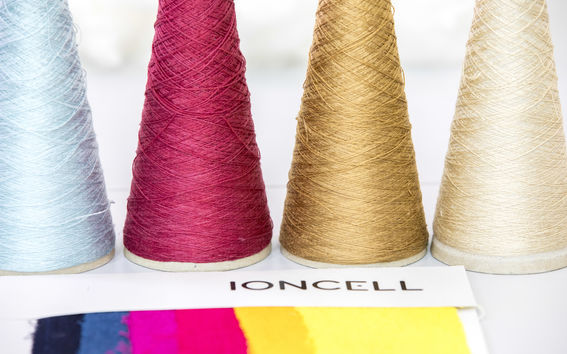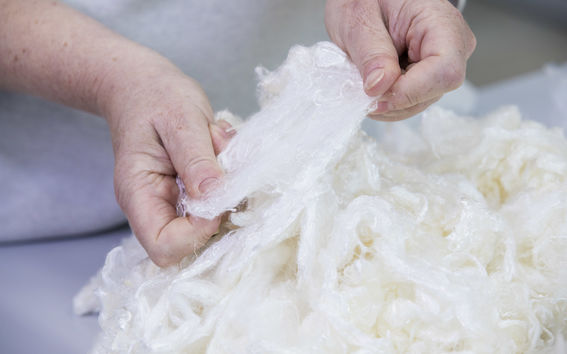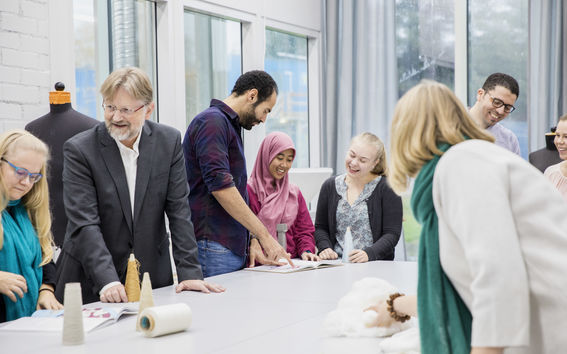Jenni Haukio to wear gown made of sustainable Ioncell material at December’s Independence Day reception

Examples of dyed Ioncell threads and fabric swatches for earlier projects. Photo: Mikko Raskinen / Aalto University
Jenni Haukio, spouse of Finnish President Sauli Niinistö, will wear an Aalto University-created evening gown to this year’s Independence Day reception on 6 December. The dress, currently in production, will be made with birch-based Ioncell fibre from Finland’s plentiful forests. The 6 December event, which takes place at the Presidential Palace in Helsinki, is the most watched programme on Finnish television each year.
Developed at Aalto University and the University of Helsinki, the Ioncell process creates quality textile fibres from wood or recycled materials such as recycled newspaper or cardboard and cotton waste. Ioncell fibre is an ecological alternative to environmentally demanding cotton, oil-based polyester or viscose, which is produced using toxic chemicals.
‘Fabric made from Ioncell is soft to touch. It has a lovely sheen, falls beautifully and takes colour well. Ioncell is a fascinating material, and can be used also for the formalwear. Most importantly, it’s an environmentally sustainable option,’ says Pirjo Kääriäinen, Professor of Practice at Aalto University.
Using the same process, used Ioncell fabrics can also be recycled—multiple times—to create new fibres.
‘Ioncell fibres made from recycled materials are of excellent quality. With our process, fibres made, for example from old jeans, are actually stronger than the originals,’ explains Marja Rissanen, Aalto’s expert in textile technology.
Aalto University and the University of Helsinki have developed the Ioncell method over the course of several years. The team—made up of students and experts in wood processing, chemistry, engineering as well as textile and fashion design—is currently producing small batches of trial fibres and materials. According to Pirjo Kääriäinen, the multidisciplinary collaboration holds tremendous strength for long-term material research.
‘We have the full production line at Aalto, from fibre and yarn spinning to producing textiles to designing final products. And, of course, our talented students are part of the team bringing the gown to reality.’

Questions and Answers
What is Ioncell?
Ioncell is a process, developed under the leadership of Aalto University Professor Herbert Sixta, for producing cellulose-based textile fibres. The most common man-made, cellulose fibre on the market is currently viscose.
The Ioncell process makes use of a safe, non-toxic ionic liquid, developed by University of Helsinki Professor Ilkka Kilpeläinen. Wood pulp, recycled paper or cardboard and textile waste can be used as raw materials. Mrs Haukio’s dress will be made of birch pulp from Stora Enso’s factory in Joensuu, Finland.
There are three stages in creating Ioncell fibres: cellulose dissolution, fibre spinning, and recycling of the ionic liquid. Then follows garding and yarn spinning, in the same way as other textile fibres.
What makes Ioncell fibres ecological?
The global demand for textile fibres is growing each year by more than three percent. At the same time the cultivation of cotton is reducing and the hazards of oil-based, man-made fibres, like microplastics, are better recognised.
Wood grows in Finland without watering or oversight; in fact, yearly growth currently exceeds harvest and natural loss. Textile fibres made from wood have the potential to reduce carbon emissions, as recyclability means that carbon is stored for the fibre’s lifespan.
Finland has banned textile dumping in landfills in 2016 and currently about 80 per cent of recycled textiles are burned for energy, which leads to carbon being released into the atmosphere. Refining new textile fibres from waste, for example via the Ioncell process, presents one solution.
Cellulose-based Ioncell fibre is biodegradable and as a result does not release microplastics into the environment as it breaks down.

When can Ioncell products be purchased?
At the moment Ioncell is at the research stage. To date, the team has created a number of unique products using the process, such as dresses, scarves, a jacket and iPad case.
Preparations for a pilot production line have already begun; it is estimated to be in use by 2020. The resulting fibre production will be significantly larger in scale than in the laboratory. If successful, the process could be ready for industrial production in 2025.

More information:
Pirjo Kääriäinen
Professor of Practice, Aalto University
Telephone: +358 50 381 0217
pirjo.kaariainen@aalto.fi
Read more news

Unite! Seed Fund 2026: Open for applications
The 2026 Unite! Seed Fund call is officially open, offering funding across three strategic lines: Student Activities, Teaching and Learning, and Research and PhD. Deadline for applications is 20 March 2026.
Apply now: Unite! Seed Fund 2026 - Student Call
The Unite! Seed Fund call for 2026 is now open for students. Apply now for up to €20,000 per project, involving at least two Unite! Universities. Deadline for applications is 20 March 2026.






